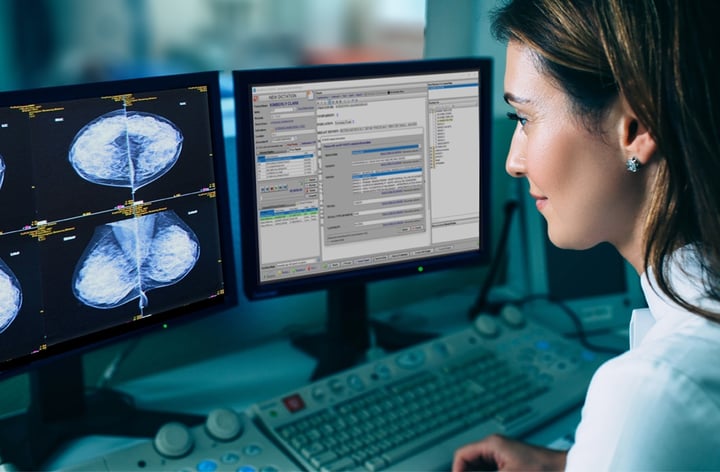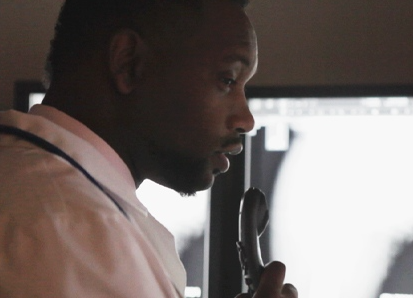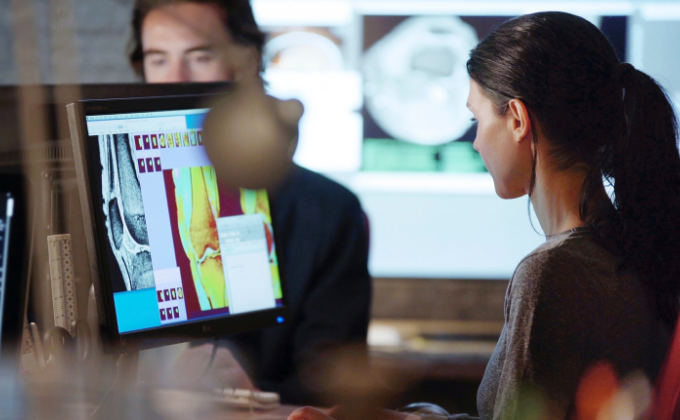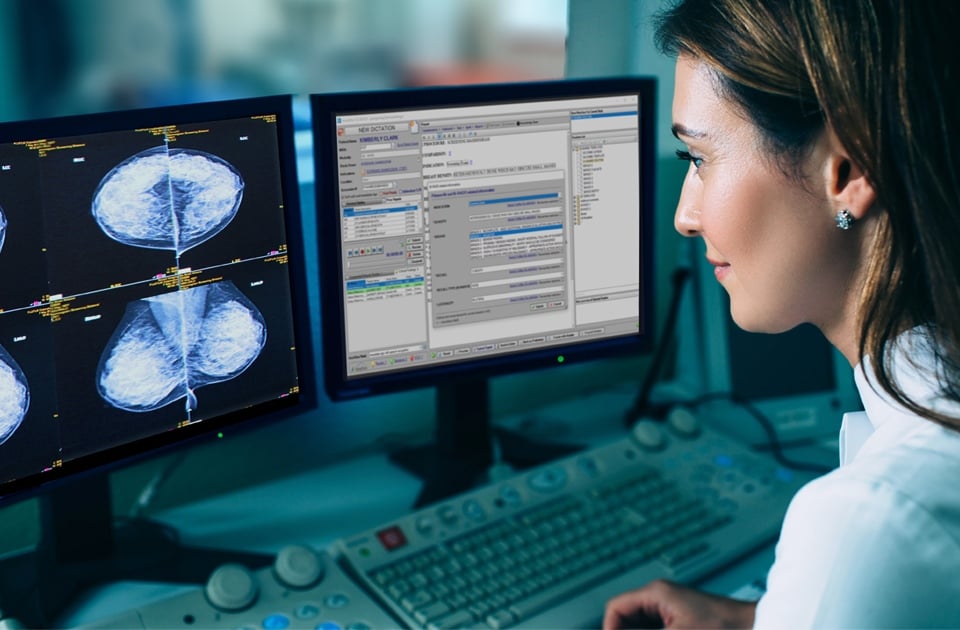In recent years, the field of radiology has seen a dramatic shift towards the integration of AI and voice recognition technologies. These innovations have the potential to revolutionize radiology workflows, improving efficiency, accuracy, and patient outcomes. In this article, we will explore the role of AI and voice recognition in streamlining radiology workflows, understanding the technologies involved, the current state of radiology practices, and the future implications of these advancements.
Understanding AI and Voice Recognition Technologies
AI, or artificial intelligence, is a branch of computer science that focuses on creating intelligent machines capable of performing tasks that typically require human intelligence. In the context of radiology, AI can analyze medical images, detect anomalies, and assist radiologists in diagnosing diseases. Voice recognition, on the other hand, refers to the technology that converts spoken words into written text. By combining AI and voice recognition, radiologists have the potential to streamline their workflows and enhance their diagnostic capabilities.

Defining AI in the Context of Radiology
Within the field of radiology, AI refers to the use of computer algorithms to analyze medical images and assist radiologists in making diagnoses. These algorithms are trained on vast datasets of annotated medical images, allowing them to learn patterns and identify abnormalities with a high level of accuracy. AI can help radiologists by flagging suspicious findings, prioritizing urgent cases, and reducing the workload associated with image interpretation.
One of the key advantages of AI in radiology is its ability to analyze medical images at a speed much faster than human radiologists. While a human radiologist may take several minutes to analyze a single image, an AI algorithm can process hundreds of images in a matter of seconds. This speed allows for quicker diagnosis and treatment planning, potentially saving lives in urgent cases.
Furthermore, AI algorithms can continuously learn and improve over time. As more data becomes available and new patterns are discovered, the algorithms can be updated to enhance their diagnostic accuracy. This iterative learning process ensures that the AI systems in radiology are always up-to-date with the latest medical knowledge and advancements.
The Mechanics of Voice Recognition Systems
Voice recognition systems utilize sophisticated software algorithms to convert spoken words into written text. These systems employ a combination of machine learning and natural language processing techniques to accurately transcribe spoken language. In the context of radiology, voice recognition systems allow radiologists to efficiently dictate their findings, reducing the time spent on manual data entry and increasing productivity.
One of the challenges in developing voice recognition systems for radiology is the need for specialized medical vocabulary. Radiologists often use complex medical terms and abbreviations in their reports, which can be difficult for standard voice recognition systems to accurately transcribe. To overcome this challenge, developers are working on training voice recognition algorithms specifically for radiology, incorporating medical terminology and context into the transcription process.
Another important aspect of voice recognition systems is their ability to adapt to individual radiologists' speech patterns and accents. By analyzing a radiologist's voice recordings and making adjustments to the recognition algorithms, these systems can achieve higher accuracy and reduce errors caused by variations in speech patterns.
The Current State of Radiology Workflows
Radiology practices face numerous challenges in their daily workflows. The increasing volume of medical imaging studies, the demand for faster turnaround times, and the pressure to provide accurate diagnoses all contribute to the complexity of radiology workflows. Moreover, the manual processes involved in image interpretation, report generation, and data entry can be time-consuming and prone to errors.
In addition to these challenges, radiologists also have to navigate through a myriad of regulatory requirements and compliance standards. The ever-evolving landscape of healthcare regulations adds another layer of complexity to their already demanding workflows. Staying up-to-date with these regulations and ensuring compliance is crucial to providing quality patient care.
Common Challenges in Radiology Practices
- The increasing volume of imaging studies: Radiologists are faced with a growing number of imaging studies to review, leading to potential backlogs and delays in diagnosis. This surge in imaging studies can be attributed to the advancements in technology, which have made medical imaging more accessible and affordable.
- Faster turnaround times: Patients and healthcare providers expect prompt results, necessitating efficient workflows to ensure timely diagnoses and treatment plans. Radiologists are under constant pressure to deliver accurate reports within tight timeframes, often working against the clock to meet these expectations.
- Accuracy and consistency: Radiologists strive for accurate interpretations, but human error and variability can introduce inconsistencies in diagnoses. The subjective nature of image interpretation, coupled with the sheer volume of studies, increases the likelihood of errors. Radiologists must constantly refine their skills and rely on quality assurance measures to minimize diagnostic discrepancies.
Addressing these challenges requires a multi-faceted approach. Radiology practices are increasingly turning to technology to streamline their workflows and improve efficiency.
The Impact of Technology on Radiology
Advancements in technology have had a profound impact on radiology practices. The adoption of digital imaging modalities, picture archiving and communication systems (PACS), and electronic health records (EHRs) has improved data accessibility and facilitated communication between healthcare providers. These technological advancements have revolutionized the way radiologists work, enabling them to view and interpret images remotely, collaborate with colleagues, and share patient information seamlessly.
Furthermore, artificial intelligence (AI) and machine learning algorithms are being integrated into radiology workflows, assisting radiologists in image analysis and interpretation. These AI-powered tools have the potential to enhance accuracy, reduce variability, and expedite the diagnostic process. By leveraging these technologies, radiologists can focus their expertise on complex cases and critical decision-making, while routine tasks are automated.
However, the increasing complexity of radiology workflows and the growing demand for faster and more accurate diagnoses call for further innovations in the field. Radiology practices are exploring new technologies such as natural language processing (NLP) and voice recognition software to streamline reporting processes and improve documentation efficiency. These tools enable radiologists to dictate reports in real-time, reducing the time spent on manual data entry and enhancing overall productivity.
In conclusion, the challenges faced by radiology practices in their daily workflows are multifaceted. From managing the increasing volume of imaging studies to striving for faster turnaround times and maintaining accuracy, radiologists are constantly seeking ways to improve their processes. Technology has played a pivotal role in transforming radiology practices, but further innovations are needed to address the evolving demands of the field. By embracing these advancements and leveraging the power of technology, radiologists can enhance patient care, improve efficiency, and ultimately contribute to better health outcomes.
Integrating AI and Voice Recognition into Radiology
The integration of AI and voice recognition technologies into radiology practices holds immense potential for improvement. These technologies can assist radiologists in their daily tasks, allowing them to work more efficiently and accurately. Let's explore the potential benefits of this integration and the impact it can have on diagnostics.

Potential Benefits for Radiologists
- Increased efficiency: AI algorithms can help radiologists by prioritizing urgent cases, flagging critical findings, and reducing the time spent on manual analysis.
- Enhanced accuracy: AI can assist radiologists in detecting subtle abnormalities that may not be easily discernible to the human eye, improving diagnostic accuracy.
- Improved productivity: Voice recognition systems enable radiologists to dictate their findings quickly and accurately, reducing the need for manual data entry and enhancing productivity.
Improving Efficiency and Accuracy in Diagnostics
By leveraging AI and voice recognition technologies, radiologists can streamline their workflows and improve diagnostic capabilities. AI algorithms can analyze medical images and provide radiologists with an initial analysis, flagging areas of concern or potential abnormalities. This integration not only saves time but also enhances accuracy by minimizing potential human errors in data entry and interpretation.
Imagine a scenario where a radiologist is reviewing a chest X-ray of a patient suspected to have lung cancer. With the integration of AI and voice recognition, the radiologist can upload the image to a specialized software that utilizes AI algorithms. The software quickly analyzes the image, highlighting any suspicious areas that require further attention. This initial analysis serves as a valuable aid to the radiologist, allowing them to focus their expertise on the areas of concern.
Furthermore, voice recognition systems play a crucial role in improving efficiency during the diagnostic process. Instead of spending valuable time manually entering data or typing out reports, radiologists can simply dictate their findings using voice recognition software. This not only saves time but also reduces the risk of transcription errors that can occur during manual data entry.
Moreover, the integration of voice recognition systems can significantly enhance the accuracy of radiology reports. Radiologists can verbally describe their observations, providing detailed information about the size, location, and characteristics of any abnormalities detected. This comprehensive documentation ensures that important details are accurately captured, minimizing the chances of miscommunication or incomplete information in the final report.
Another advantage of AI and voice recognition integration is the ability to access and review previous cases more efficiently. With AI algorithms analyzing and categorizing medical images, radiologists can easily search for similar cases in the database. This feature allows for quick comparisons and reference, aiding in the diagnostic process and potentially uncovering patterns or trends that may have been missed otherwise.
In conclusion, the integration of AI and voice recognition technologies into radiology practices has the potential to revolutionize the field. By improving efficiency, enhancing accuracy, and streamlining workflows, radiologists can provide better patient care and make more informed decisions. The future of radiology is undoubtedly intertwined with these innovative technologies, promising a brighter and more advanced approach to diagnostics.
The Future of AI and Voice Recognition in Radiology
The future of AI and voice recognition in radiology holds numerous exciting possibilities. As technology continues to evolve, so too will the applications and benefits these advancements bring to the field.

Imagine a world where radiologists can rely on highly advanced AI algorithms and voice recognition systems to enhance their diagnostic capabilities. With the continuous development of AI algorithms, these systems will become increasingly sophisticated, enabling even more accurate image analysis and detection of subtle abnormalities. This means that radiologists will be able to rely on AI to assist them in identifying and interpreting complex medical images, leading to more precise diagnoses and better patient outcomes.
But it doesn't stop there. The integration of AI and voice recognition with other emerging technologies, such as augmented reality and virtual reality, will further revolutionize the field of radiology. Imagine being able to visualize medical images in a three-dimensional space, allowing radiologists to explore and analyze the human body in ways that were previously unimaginable. This integration will not only enhance diagnostic capabilities but also improve the communication and collaboration between radiologists and other healthcare professionals.
Another exciting development in the future of AI and voice recognition in radiology is the advancement of natural language processing. Voice recognition systems will become more adept at understanding complex medical terminology and synthesizing radiologists' findings accurately. This means that radiologists will be able to dictate their observations and findings directly into the system, saving time and effort while ensuring accurate documentation of their assessments.
Preparing for a Tech-Driven Future in Radiology
As AI and voice recognition technologies continue to advance, it is essential for radiologists to adapt to this tech-driven landscape. Continuous education and training in utilizing these technologies effectively will be crucial for radiologists to stay at the forefront of their field. Embracing these advancements will enable radiologists to provide improved patient care, enhance diagnostic accuracy, and streamline their workflows.
With the integration of AI and voice recognition technologies, radiologists will be able to focus more on the interpretation and analysis of medical images, rather than spending excessive time on administrative tasks. This shift will not only increase efficiency but also allow radiologists to dedicate more time to patient interaction and personalized care.
Furthermore, the future of AI and voice recognition in radiology will require radiologists to develop new skills and competencies. They will need to become proficient in utilizing AI algorithms and voice recognition systems, understanding their limitations, and interpreting the results they provide. Continuous professional development and collaboration with experts in the field will be essential to ensure that radiologists are well-prepared for the challenges and opportunities that lie ahead.
In conclusion, AI and voice recognition technologies have the potential to revolutionize radiology workflows. By integrating these technologies into daily practices, radiologists can improve efficiency, accuracy, and patient outcomes. The future of AI and voice recognition holds exciting possibilities, and it is crucial for radiologists to embrace this tech-driven landscape to continually enhance diagnostic capabilities, adapt to advancements, and provide the best possible care to their patients.







